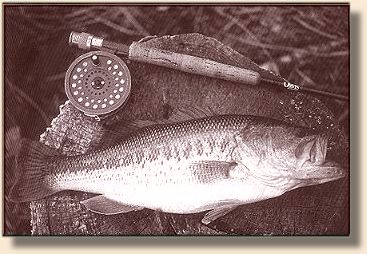Bass

Many books have been written on the subject of bass
and there are probably a dozen magazines that are
written specifically for bass fishing. Television
shows and numerous regional, national and international
tournaments have been based on bass fishing. I think
more money has been spent designing and marketing boats,
rods, reels, tackle and baits for this family of fish
than the rest combined. So what is so special about
this species of fish that attracts so much hoopla?
That's an easy question to answer, as far as I'm concerned:
1.) There's an extremely wide territory that the
species can be found. Literally, bass can be found coast
to coast from Canada through South America.
2.) It has a very wide range of conditions that
it has adapted to live in, from muddy swamps, farm ponds
and lakes to clear, pristine, fast moving rivers.
3.) There are a large number of subspecies, large
mouth, small mouth, rock, white, striper, wiper (hybrids),
peacock, and sea bass.
4.) Finally, and in my opinion, probably the most
important, they are easy to catch at almost any time
of the day and all year long.
Bass are generally territorial, aggressive fish. Many
times bass will strike a bait, regardless of the type,
merely because it's in its territory, not necessarily
because it's hungry. That's what makes it easy. Bass
also relate primarily to structure of some sort, fallen
trees, logs, rocks, reefs, sand bars, weed beds, docks,
etc. Find the structure and you'll find the fish. Find
the fish; toss a fly into its territory, and it'll strike.
It's really pretty simple.
One real variable I've found to catching bass is the
weather, especially large, windy storms with a lot
of lightening and thunder or an extreme cold front.
In a case like this the fish normally will go to the
deeper areas of the water for a day or two then resume
its normal feeding and territorial patterns. The spring
spawn is one other variable. The bass will leave its
normal haunts and head for the spawning grounds, they
become extremely aggressive at this time. One important
factor here is that it's the males who build the nest,
take care of the eggs and protect the new hatchings
(for up to a month) after the eggs hatch. If you are
fishing a spawning bed please be sure and release the
fish as safely and quickly as possible so that they
can get back to their beds and take care of business.
Ok, what to use for fly fishing for bass. In this
part of the country, the upper Midwest, the white,
stripers and hybrid wipers tend to run in large
schools which many times can be seen "finning" (the
dorsal fins actually extend out of the water) at the
surface of the water. When they're in large schools,
feeding on bait fish, toss them a streamer (match
the hatch). I have lost track of the number of whites
and stripers I've caught on a Clouser or Muddler tied
with a medium to light brown top, a dark brown middle
and a white bottom. I tie these from size #6 to #1 and
use very little weight or a very slow sink tip line.
Mend the line erratically during the retrieval so it
looks like an injured bait fish, wait for the hit and
hold on. I've followed a feeding school around for
several hours at different times, catching as many
as 30 fish in a couple of hours. Unlike other species
of bass, fighting and making a disturbance in the middle
of a feeding frenzy doesn't seem to disturb the school
in the least. We've been able to float up to within 15
to 20 feet of the school without bothering them. It's
a real ego booster after a dry spell to get into these
fish.
The black bass, large mouth, small mouth and rock bass
are more prone to be found one or two per location.
Other than during spawning, I've never run into a
school of them. In my humble opinion though, pound
for pound, the small mouth bass is one of the best
fighting fish there is, not to mention, pretty good
table fare. I usually start out fishing with poppers,
from about ½ inch to ¾ inch in size. My favorites have
either legs or whiskers made from "living rubber" and
a marabou feather tail. The color is dependent on the
weather and the time of year. Again, on overcast days
I use a darker colored popper, bright sunny days, and
a lighter colored popper. The other thing to keep in
mind is the time of year. Around here frogs don't start
appearing until late April or early May so using a frog
colored popper in early March probably won't work too
well. Another favorite is the streamer, a Clouser, Spruce,
or Silver will all work well. 3 to 4 inch bunny tails and
marabou leaches also work very well when mended erratically
along the structure cover. One of the best flies I use is
the crawdad (or crayfish) tied on a # 8 to # 4 hook. These
flies work especially well along a rocky shoreline or a
midstream or lake drop off. The best tip I can give you
on using a crayfish fly is to remember how a crayfish swims;
in a rhythmic, slow, up and down motion.
Other top water flies that work well on bass are hoppers,
crickets, and ants. For deep running flies try a large
hellgrammite or stonefly. That's probably what I like
best about bass, they're not real fussy. When I've
cleaned bass I'm always surprised to see what's in
their stomachs. There's usually a little bit of
everything that's in the local water, crayfish,
minnows, frogs, insects. In one I found an entire
spinner rig, complete with plastic worm!
Another great thing about bass is that you can catch
them from shore, in a float tube or from a boat. They're
usually found fairly close to the shore line where the
sides are rocky and the bottom drops down fairly quickly.
But other times along the sides of an eddy formed by a
rock midstream or next to stumps or downed logs and
along the edges of weedbeds. They like to ambush their
prey, streaking out from their hiding place, grabbing
it and heading back for cover. If you get a hit, but
miss the hook set, keep trying the same area for a while,
many times you'll irritate the fish into another hit.
If you've ever been using a popper or other top water
fly and had a small mouth come crashing through the
surface and engulf your fly you'll never forget that
adrenaline rush of the explosive power of this fish.
If you've never fished for bass on a fly rod you're
really missing some major action! So tie something
on and give it a try, you won't be disappointed.
fritzfratz@earthlink.net.
~ Fritz Fratz
|





